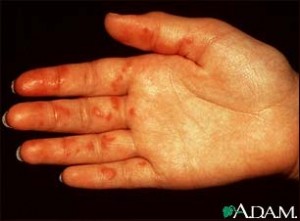Alternate Names : Vasculitis – allergic, Hypersensitivity vasculitis, Cutaneous leukocytoclastic vasculitis
Definition
Allergic vasculitis is an extreme reaction to a drug, infection, or foreign substance that leads to inflammation and damage to blood vessels of the skin.
Overview, Causes, & Risk Factors
Allergic vasculitis is caused by an allergic reaction to a drug or other foreign substance. Most patients are older than 15 years.
Even with a thorough history, the cause of this condition cannot be identified.
Pictures & Images
Vasculitis on the palm
These spots of blood under the skin (purpura) are caused by vasculitis. They do not turn white with pressure (non-blanchable). In this particular case, the purpura are associated with an underlying disorder affecting the structure of the blood vessel walls (collagen-vascular disorder).
Vasculitis

Inflammation of the blood vessels (vasculitis) may be caused when antibodies that have attached to antigens in the blood (immune complexes), attach to the blood vessel walls. These purplish spots can be felt in the skin. They do not turn white (blanch) when pressed. As the condition progresses, they may become larger and more bruise-like (ecchymotic), and some may develop central ulceration or necrosis (tissue death).
Vasculitis, urticarial on the hand

These red (erythematous), hive-like (urticarial) spots (plaques) are caused by inflammation of the blood vessels (urticarial vasculitis) and do not change over a 24-hour period. They may or my not turn white (blanch) with pressure.
Allergic vasculitis: Overview, Causes
Allergic vasculitis: Symptoms & Signs, Diagnosis & Tests
Allergic vasculitis: Treatment
Review Date : 5/31/2009
Reviewed By : Mark James Borigini, Associate Clinical Professor of Medicine, University of California, Irvine, Irvine, CA. Review provided by VeriMed Healthcare Network. Also reviewed by David Zieve, MD, MHA, Medical Director, A.D.A.M., Inc.

